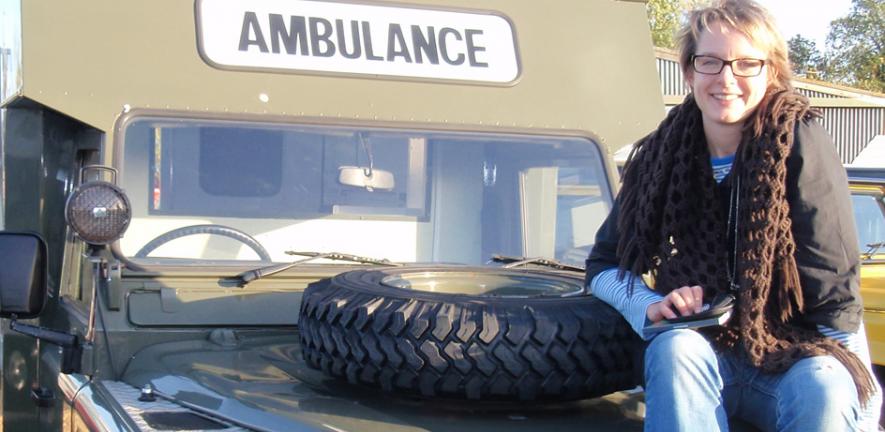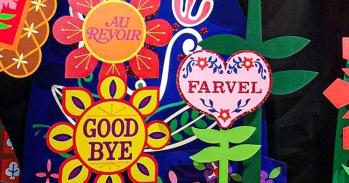
A decommissioned Land Rover ambulance will be home to Cambridge University’s Dr Emily Lethbridge from December – as she begins an epic year-long research trip around Iceland investigating the deep-rooted significance of its centuries-old sagas.
A decommissioned Land Rover ambulance will be home to Cambridge University’s Dr Emily Lethbridge from December – as she begins an epic year-long research trip around Iceland investigating the deep-rooted significance of its centuries-old sagas.
Even though they are hundreds of years old, the sagas are still widely celebrated. They are a uniquely important part of Iceland's cultural heritage.
Dr Emily Lethbridge
Emily, 31, intends to rely on the ex-MoD ambulance - and the kindness of strangers - as she makes her way across the wilds of Iceland on the trail of the Íslendingasögur ('sagas of Icelanders').
The Íslendingasögur, written down in the 13th and 14th centuries, are enormously important in Icelandic literary history and are entrenched in the national consciousness. To this day, they are taught in schools around the country and are a central part of Icelandic culture.
The sagas focus on Iceland and Icelandic society in the 9th, 10th and 11th centuries, and describe both the everyday life of the first generations of island-settlers, and the conflicts that arose between individuals and families. Along the way, they present a great number of highly individual and memorable characters.
Starting from the east of the island and criss-crossing the country, Emily will visit the physical settings of all 30 plus sagas over the course of her year's self-funded research.
Emily's progress - as she prepares to leave the UK and during her time in Iceland - can be followed at: http://sagasteads.blogspot.com/
She said: "My trip is going to be a 21st-century pilgrimage to the saga-steads of Iceland. I'm taking the ambulance from the UK to Denmark where I'll catch a ferry to the Faroe Islands and then, weather at sea permitting, to Iceland.
"Once in Iceland, I will travel around and across the country reading each of the sagas in the very landscapes in which they're set. I want to talk to people I meet about their personal interests in local sagas and hope to record their oral responses to the events and characters portrayed in them."
"Even though they are hundreds of years old, the sagas are still widely celebrated. They are a uniquely important part of Iceland's cultural heritage. People there are much more familiar with the sagas than the British are with the most important works of English literature - the works of Shakespeare, or Dickens, for example - although the sagas are much older.
"This is partly on account of the Icelandic language not changing much over time, and partly because of the island's history. But essentially, they are about human nature, and many of them are incredibly compelling stories concerned with honour and reputation, vengeance, love, desire and death."
Emily has already spent time in Iceland, spending the summer of 2008 working on a dairy farm to immerse herself in the language and culture of the country.
In preparation for her next trip, however, she has had to learn a host of new skills, including the inner workings of a 20-year-old former Ministry of Defence Land Rover.
She spent several days among mechanics in a Peterborough garage learning how to service and maintain the vehicle and has also learned how to drive off-road, fish, and attended a St John's Ambulance first-aid course covering outdoor emergencies and extremes of temperature. Winter weather in Iceland can be fierce with extremely strong winds and only a few hours of daylight.
Emily added: "The countryside and hugely varied landscapes always have the wow factor in photos, but first-hand, they are inconceivably beautiful and powerful. And the sagas are so fundamentally rooted in the landscape that I believe it is difficult to understand them without being familiar with the country itself, in different seasons and conditions.
"Iceland is a relatively isolated country, but although much has changed socially, politically and economically over the past century, there is also continuity between the past and present in some aspects of Icelandic life and most importantly, in the country´s natural environment.
"One of the underlying objectives of my year-long research trip and the book I intend to write is to show people back in the UK that there is more to Iceland than fishing, failed banking systems and volcanic ash clouds."
"The sagas were copied continuously by hand from the 13th to the 20th century - the printing press never having displaced that tradition - and they were read aloud in farmhouses during winter evenings, in some cases right up until the introduction of the first national radio station in the 1930s. By reading the sagas 'in situ', I want to explore the country's remarkable culture against the background of its extreme landscape - and most importantly, I want to communicate this in an engaging way to people outside of Iceland who may never have heard of the sagas before."
This work is licensed under a Creative Commons Licence. If you use this content on your site please link back to this page.





